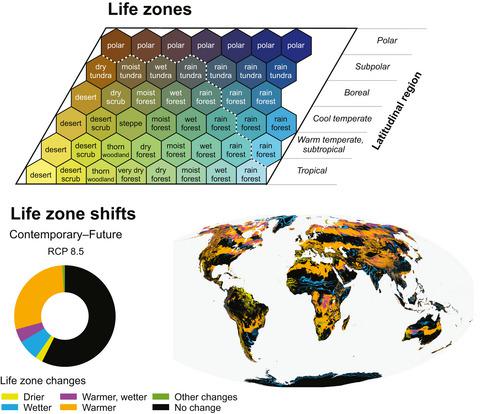当前位置:
X-MOL 学术
›
Glob. Change Biol.
›
论文详情
Our official English website, www.x-mol.net, welcomes your
feedback! (Note: you will need to create a separate account there.)
Accelerated shifts in terrestrial life zones under rapid climate change
Global Change Biology ( IF 10.8 ) Pub Date : 2021-10-30 , DOI: 10.1111/gcb.15962 Paul R Elsen 1, 2 , Earl C Saxon 3, 4 , B Alexander Simmons 5, 6 , Michelle Ward 3, 7, 8 , Brooke A Williams 3, 8 , Hedley S Grantham 1 , Salit Kark 9 , Noam Levin 4, 10 , Katharina-Victoria Perez-Hammerle 3, 11 , April E Reside 3 , James E M Watson 3, 8
Global Change Biology ( IF 10.8 ) Pub Date : 2021-10-30 , DOI: 10.1111/gcb.15962 Paul R Elsen 1, 2 , Earl C Saxon 3, 4 , B Alexander Simmons 5, 6 , Michelle Ward 3, 7, 8 , Brooke A Williams 3, 8 , Hedley S Grantham 1 , Salit Kark 9 , Noam Levin 4, 10 , Katharina-Victoria Perez-Hammerle 3, 11 , April E Reside 3 , James E M Watson 3, 8
Affiliation

|
Rapid climate change is impacting biodiversity, ecosystem function, and human well-being. Though the magnitude and trajectory of climate change are becoming clearer, our understanding of how these changes reshape terrestrial life zones—distinct biogeographic units characterized by biotemperature, precipitation, and aridity representing broad-scale ecosystem types—is limited. To address this gap, we used high-resolution historical climatologies and climate projections to determine the global distribution of historical (1901–1920), contemporary (1979–2013), and future (2061–2080) life zones. Comparing the historical and contemporary distributions shows that changes from one life zone to another during the 20th century impacted 27 million km2 (18.3% of land), with consequences for social and ecological systems. Such changes took place in all biomes, most notably in Boreal Forests, Temperate Coniferous Forests, and Tropical Coniferous Forests. Comparing the contemporary and future life zone distributions shows the pace of life zone changes accelerating rapidly in the 21st century. By 2070, such changes would impact an additional 62 million km2 (42.6% of land) under “business-as-usual” (RCP8.5) emissions scenarios. Accelerated rates of change are observed in hundreds of ecoregions across all biomes except Tropical Coniferous Forests. While only 30 ecoregions (3.5%) had over half of their areas change to a different life zone during the 20th century, by 2070 this number is projected to climb to 111 ecoregions (13.1%) under RCP4.5 and 281 ecoregions (33.2%) under RCP8.5. We identified weak correlations between life zone change and threatened vertebrate richness, levels of vertebrate endemism, cropland extent, and human population densities within ecoregions, illustrating the ubiquitous risks of life zone changes to diverse social–ecological systems. The accelerated pace of life zone changes will increasingly challenge adaptive conservation and sustainable development strategies that incorrectly assume current ecological patterns and livelihood provisioning systems will persist.
中文翻译:

气候快速变化下陆地生命带加速变化
迅速的气候变化正在影响生物多样性、生态系统功能和人类福祉。尽管气候变化的幅度和轨迹正变得越来越清晰,但我们对这些变化如何重塑陆地生命区——以生物温度、降水和干旱为特征的不同生物地理单元,代表广泛的生态系统类型——的理解是有限的。为了解决这一差距,我们使用高分辨率历史气候学和气候预测来确定历史(1901-1920)、当代(1979-2013)和未来(2061-2080)生命区的全球分布。比较历史和当代分布表明,20 世纪从一个生命区到另一个生命区的变化影响了 2700 万平方公里(18.3% 的土地),对社会和生态系统产生影响。这种变化发生在所有生物群落中,最显着的是北方森林、温带针叶林和热带针叶林。比较当代和未来的生活区分布可以看出,21世纪生活区变化的步伐正在迅速加快。到 2070 年,这些变化将影响额外的 6200 万公里2(42.6% 的土地)在“一切照旧”(RCP8.5)排放情景下。除热带针叶林外,所有生物群落的数百个生态区都观察到变化速度加快。虽然在 20 世纪只有 30 个生态区(3.5%)有超过一半的面积转变为不同的生活区,但到 2070 年,这一数字预计将攀升至 RCP4.5 下的 111 个生态区(13.1%)和 281 个生态区(33.2%) ) 在 RCP8.5 下。我们确定了生命区变化与受威胁的脊椎动物丰富度、脊椎动物特有水平、农田范围和生态区内人口密度之间的弱相关性,说明了生命区变化对不同社会生态系统的普遍风险。
更新日期:2022-01-05
中文翻译:

气候快速变化下陆地生命带加速变化
迅速的气候变化正在影响生物多样性、生态系统功能和人类福祉。尽管气候变化的幅度和轨迹正变得越来越清晰,但我们对这些变化如何重塑陆地生命区——以生物温度、降水和干旱为特征的不同生物地理单元,代表广泛的生态系统类型——的理解是有限的。为了解决这一差距,我们使用高分辨率历史气候学和气候预测来确定历史(1901-1920)、当代(1979-2013)和未来(2061-2080)生命区的全球分布。比较历史和当代分布表明,20 世纪从一个生命区到另一个生命区的变化影响了 2700 万平方公里(18.3% 的土地),对社会和生态系统产生影响。这种变化发生在所有生物群落中,最显着的是北方森林、温带针叶林和热带针叶林。比较当代和未来的生活区分布可以看出,21世纪生活区变化的步伐正在迅速加快。到 2070 年,这些变化将影响额外的 6200 万公里2(42.6% 的土地)在“一切照旧”(RCP8.5)排放情景下。除热带针叶林外,所有生物群落的数百个生态区都观察到变化速度加快。虽然在 20 世纪只有 30 个生态区(3.5%)有超过一半的面积转变为不同的生活区,但到 2070 年,这一数字预计将攀升至 RCP4.5 下的 111 个生态区(13.1%)和 281 个生态区(33.2%) ) 在 RCP8.5 下。我们确定了生命区变化与受威胁的脊椎动物丰富度、脊椎动物特有水平、农田范围和生态区内人口密度之间的弱相关性,说明了生命区变化对不同社会生态系统的普遍风险。











































 京公网安备 11010802027423号
京公网安备 11010802027423号